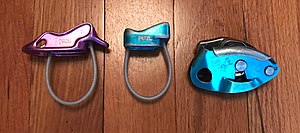
Back Descensor Catalan Sicherungsgerät German Dispositivo asegurador-descensor Spanish Système d'assurage French אמצעי חיכוך (טיפוס) HE Freno (alpinismo) Italian 懸垂下降器 Japanese Taubrems NB Przyrząd asekuracyjny Polish Спусковое устройство Russian
This article needs additional citations for verification. (March 2024) |

A belay device is a mechanical piece of climbing equipment used to control a rope during belaying.[1] It is designed to improve belay safety for the climber by allowing the belayer to manage their duties with minimal physical effort. With the right belay device, a small, weak climber can easily arrest the fall of a much heavier partner. Belay devices act as a friction brake, so that when a climber falls with any slack in the rope, the fall is brought to a stop.
Typically, when the rope is held outward, away from the body, it moves relatively freely, so the belayer can take up or pay out slack. When the rope is brought backward, to the side of the body, the rope is forced into tight bends and rubs against the device and/or against itself, allowing the belayer to arrest the descent of a climber in the case of a fall. This rubbing slows the rope, but also generates heat. Some types of belay devices can arrest a fall without the belayer taking any action, while others require the belayer to hold or pull the rope in a particular direction.
Belay devices usually attach to the harness of the belayer via a carabiner, and are usually made of aluminium or an alloy. Some belay devices can also be used as descenders for a controlled descent on a rope, that is abseiling or rappeling.
Many belay devices can be used to control either one rope, or two ropes in parallel. There are many reasons why the two-rope option might be chosen by a climber, including the consideration of reducing rope drag.
There are also auto-belay devices on the market which allow a climber to climb solo in their climbing gym.
- ^ Cox, Steven M.; Kris Fulsaas, eds. (2003). Mountaineering: The Freedom of the Hills (7 ed.). Seattle: The Mountaineers. ISBN 0-89886-828-9.